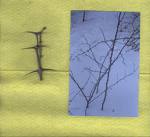Hojalito Tree Information
Images of Hojalito:






Hojalito grows in the following 8 states and provinces:
Arizona, California, Colorado, Maine, Nevada, New Mexico, Texas, UtahInformation about Hojalito:
The Robinia Neomexicana is commonly known as the Hojalito, New Mexican Locust, New Mexico Locust, Southwestern Locust as well as Una De Gato.
The currently accepted scientific name of New Mexico locust is Robinia neomexicana Gray. It is a member of the pea family (Fabaceae). Several varieties may be encountered in the literature; however, the maintenance of varieties is questionable due to intergradation of all forms .New Mexico locust is found from the mountains of Trans-Pecos Texas north to southern Colorado and west to southern Nevada . Its range extends from southeastern California to New Mexico and northern Mexico .New Mexico locust grows in pure stands or as an understory species . New Mexico locust is an understory dominant or codominant with Gambel oak (Quercus gambelii) under spruce-fir (Picea engelmannii-Abies lasiocarpa), white fir (A. concolor), and mixed-conifer forests . It is a minor component in most riparian forest and scrubland community types within its range, and in one chaparral association (Arizona oak-yellowleaf silktassel-Emory oak ) . New Mexico locust is an indicator for habitat types or plant associations in the following publications: (1) Classification of the forest vegetation on the National Forests of Arizona and New Mexico (2) A vegetation classification system for New Mexico, U.S.A. (3) Forest habitat types in the Apache, Gila, and part of the Cibola National Forests, Arizona and New Mexico (4) Forest and woodland habitat types (plant associations) of northern New Mexico and northern Arizona (5) A classification of spruce-fir and mixed conifer habitat types of Arizona and New Mexico .Some of the information provided here is attributed to:Pavek, Diane, S. 1993. Robinia neomexicana. In: Fire Effects Information System, [Online]. U.S. Department of Agriculture, Forest Service, Rocky Mountain Research Station, Fire Sciences Laboratory (Producer). , available at the USDA Fire Effects Information System (FEIS) website